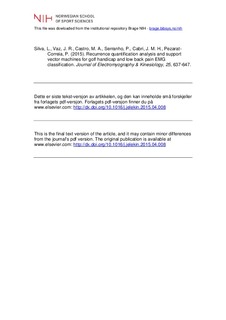| dc.contributor.author | Silva, Luís | |
| dc.contributor.author | Vaz, João Rocha | |
| dc.contributor.author | Castro, Maria António | |
| dc.contributor.author | Serranho, Pedro | |
| dc.contributor.author | Cabri, Jan | |
| dc.contributor.author | Pezarat-Correia, Pedro | |
| dc.date.accessioned | 2016-08-30T11:41:44Z | |
| dc.date.available | 2016-08-30T11:41:44Z | |
| dc.date.issued | 2015-08 | |
| dc.identifier.citation | Journal of Electromyography and Kinesiology. 2015, 25, 637-647 | nb_NO |
| dc.identifier.uri | http://hdl.handle.net/11250/2402796 | |
| dc.description | Dette er siste tekst-versjon av artikkelen, og den kan inneholde små forskjeller
fra forlagets pdf-versjon. Forlagets pdf-versjon finner du på www.elsevier.com /
This is the final text version of the article, and it may contain minor differences
from the journal's pdf version. The original publication is available at www.elsevier.com | nb_NO |
| dc.description.abstract | The quantification of non-linear characteristics of electromyography (EMG) must contain information allowing to discriminate neuromuscular strategies during dynamic skills. There are a lack of studies about muscle coordination under motor constrains during dynamic contractions. In golf, both handicap (Hc) and low back pain (LBP) are the main factors associated with the occurrence of injuries. The aim of this study was to analyze the accuracy of support vector machines SVM on EMG-based classification to discriminate Hc (low and high handicap) and LBP (with and without LPB) in the main phases of golf swing. For this purpose recurrence quantification analysis (RQA) features of the trunk and the lower limb muscles were used to feed a SVM classifier. Recurrence rate (RR) and the ratio between determinism (DET) and RR showed a high discriminant power. The Hc accuracy for the swing, backswing, and downswing were 94.4 ± 2.7%, 97.1 ± 2.3%, and 95.3 ± 2.6%, respectively. For LBP, the accuracy was 96.9 ± 3.8% for the swing, and 99.7 ± 0.4% in the backswing. External oblique (EO), biceps femoris (BF), semitendinosus (ST) and rectus femoris (RF) showed high accuracy depending on the laterality within the phase. RQA features and SVM showed a high muscle discriminant capacity within swing phases by Hc and by LBP. Low back pain golfers showed different neuromuscular coordination strategies when compared with asymptomatic. | nb_NO |
| dc.language.iso | eng | nb_NO |
| dc.publisher | Elsevier | nb_NO |
| dc.subject | electromyography | nb_NO |
| dc.subject | SVM | nb_NO |
| dc.subject | RQA | nb_NO |
| dc.subject | golf | nb_NO |
| dc.subject | pattern recognition | nb_NO |
| dc.title | Recurrence quantification analysis and support vector machines for golf handicap and low back pain EMG classification | nb_NO |
| dc.type | Journal article | nb_NO |
| dc.type | Peer reviewed | nb_NO |
| dc.subject.nsi | VDP::Social science: 200::Social science in sports: 330::Other subjects within physical education: 339 | nb_NO |
| dc.source.journal | Journal of Electromyography and Kinesiology | nb_NO |
| dc.identifier.doi | http://dx.doi.org/10.1016/j.jelekin.2015.04.008 | |
| dc.description.localcode | Seksjon for fysisk prestasjonsevne / Department of Physical Performance | nb_NO |
